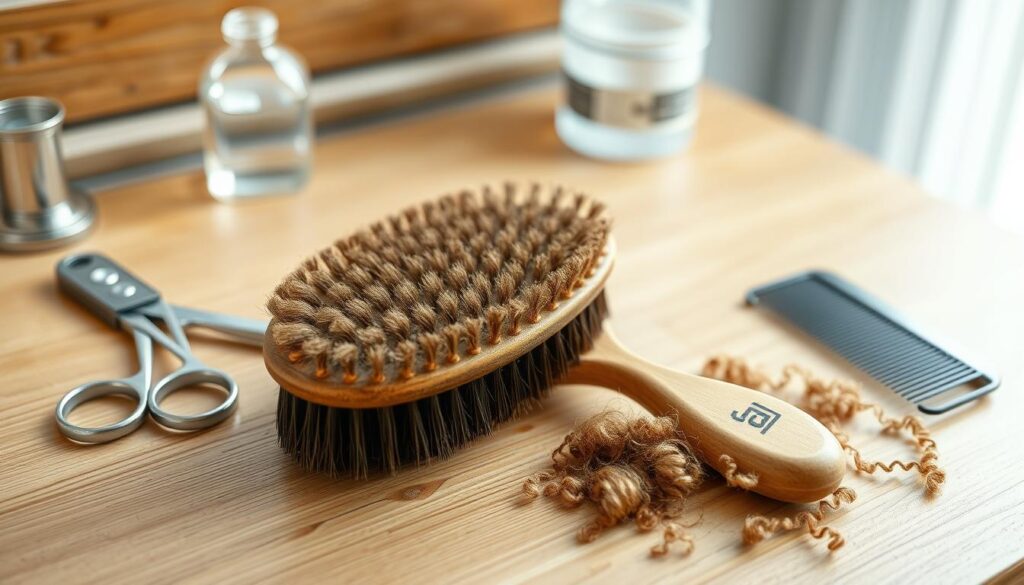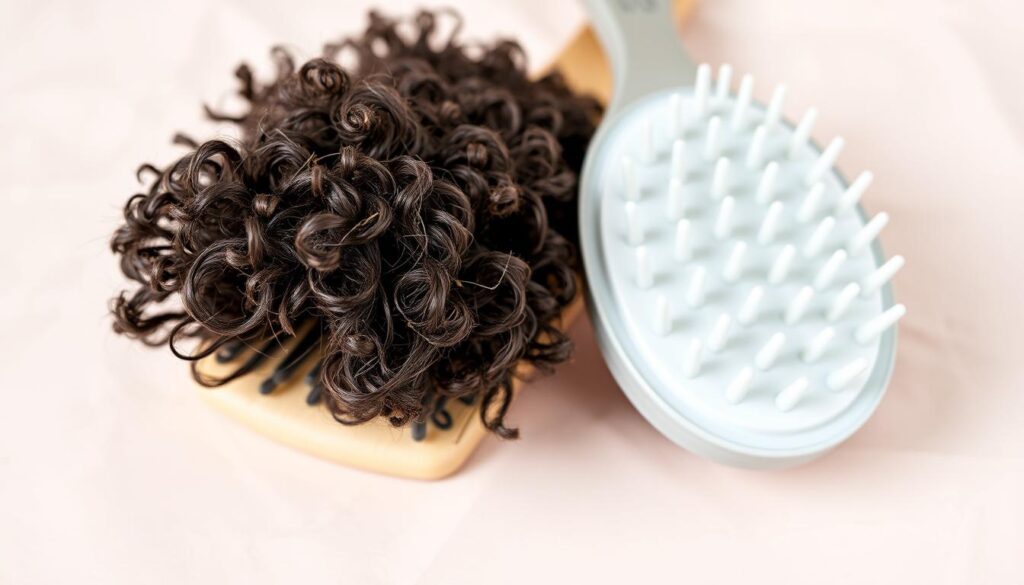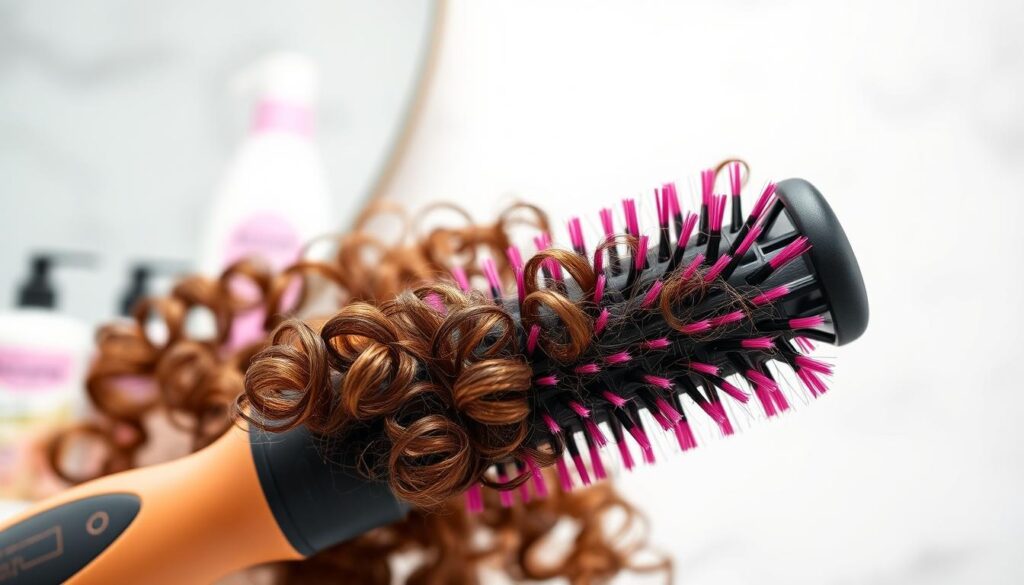Are you unknowingly causing more harm than good to your precious curls? Curly hair needs special care, and brushing is no exception. Avoid these top 5 mistakes to prevent frizz, breakage, and a disrupted curl pattern.
Key Takeaways
- Brushing curly hair with the wrong type of brush can lead to frizz and damage
- Detangling dry curly hair causes unnecessary breakage and disrupts the curl pattern
- Aggressive brushing techniques can lead to hair loss and long-term damage
- Neglecting to clean your curly hair brush regularly can harbor bacteria and product buildup
- Incompatible hair products and brushes can counteract each other’s benefits
Understanding the Impact of Improper Brush Usage on Curly Hair
Brushing curly hair the wrong way can really hurt your curls and hair health. Bad brushing can mess up your curls, causing frizz, tangles, and damage. Knowing how curls form and how brushing affects them is key to keeping your curls bouncy and beautiful.
How Incorrect Brushing Affects Curl Pattern
Your hair’s cuticle and natural oils are key to your curl pattern. Harsh brushing can damage the hair shaft, lifting the cuticle and messing up curl formation. This can make your curls lose definition, get frizzy, and look unruly.
The Science Behind Curl Formation and Brushing
Your curls’ shape comes from how your hair grows out of the follicle. Curly hair has a special spiral pattern shaped by its layers. Aggressive brushing can mess with this, making your hair frizzy and hard to manage.
To keep your curls healthy and defined, use a good anti-frizz brush made for your curl pattern and hair type. Gentle brushing helps keep your curls natural and reduces hair damage.
“Brushing curly hair incorrectly can lead to frizz, tangles, and breakage. Utilizing the right tools and techniques is essential for maintaining healthy, defined curls.”
Understanding curl formation and the wrong way to brush can help you care for your curly hair better. This knowledge lets you choose the best brushes, products, and methods to keep your curls looking great.
Why Your Curly Hair Brush Choice Matters
Choosing the right brush is key to healthy, vibrant curls. Different brushes, like wide-tooth combs, Denman brushes, and Tangle Teezers, serve specific purposes. Knowing how they work with your curls is essential for great hair.
Wide-tooth combs are great for detangling curls gently. They have wide teeth that avoid tangling your curls. Denman brushes, with their special bristles, are perfect for styling and defining curls.
A Tangle Teezer is a must-have for dealing with tough knots. Its flexible teeth make detangling easy, reducing breakage and frizz. The right brush can greatly improve your curls’ health and look.
The material and bristle type of your brush also matter. Natural bristles, like those in bamboo brushes, are softer on curls. Synthetic bristles might cause more damage. A good, curly hair brush can change your styling game.
“The Felicia Leatherwood Detangling Brush is a game-changer for my curly clients. It gently works through knots without causing breakage or frizz.” – Genese Cervantes, My Curl Connection
Whether you need to detangle, style, or maintain your curls, the right brush is essential. Look into wide-tooth combs, Denman brushes, and Tangle Teezers. Find the perfect one for your curls and styling needs.
The Most Common Brushing Mistake: Dry Hair Detangling
Detangling curly hair when it’s dry is a big mistake. It can cause breakage, frizz, and mess up your curls. To keep your curls healthy and vibrant, it’s important to know the right time and way to detangle.
Best Time to Detangle Curly Hair
The best time to detangle curly hair is when it’s wet. Use a moisturizing leave-in conditioner to make it easier and gentler. Don’t brush or comb dry hair, as it can damage it a lot.
Wet Brushing vs. Dry Brushing
Wet brushing is best for curly hair. Use a wide-tooth comb or detangling brush to keep your curls intact and prevent breakage. Dry brushing can be too harsh and cause frizz and damage.
Product Recommendations for Detangling
- A wet brush or wide-tooth comb is ideal for gently detangling your hair when it’s wet and conditioned.
- Apply a nourishing leave-in conditioner before brushing to help smooth and detangle your curls.
- For extra slip and protection, consider using a detangling brush designed for curly hair.
By following these tips, you can avoid the mistake of detangling dry hair. This will help your curls look their best.
Using the Wrong Type of Curly Hair Brush
Choosing the right brush for your curly hair is key. Brushes for straight hair can harm your curls. Instead, pick brushes made for curls, like those from DevaCurl or Mixed Chicks.
These special brushes help your curls look their best. They have soft, flexible bristles that move through curls gently. Using a straight hair brush can make your curls look dull and frizzy.
Find a brush that fits your curl type. Whether you have tight coils or loose waves, there’s a curl-specific brush for you. It will make your hair look amazing.
| Brush Type | Ideal Curl Type | Key Features | Price Range |
|---|---|---|---|
| Paddle Brush | Wavy to Loose Curls | Boar Bristle, Smoothing | $12 – $30 |
| Vent Brush | Tight Curls | Metal/Ionic, Detangling | $8 – $18 |
| Detangling Brush | All Curl Types | Wide-Toothed, Plastic | $10 – $22 |
With the right curl-specific brush, styling and detangling your curls is easy. Get the right tools and let your natural texture shine.
Aggressive Brushing Techniques and Their Consequences
Brushing your curly hair too hard or using the wrong way can cause big problems. It can lead to hair breakage, split ends, and losing curl definition. Knowing how to brush right and understanding the damage signs are key to keeping your curls healthy and beautiful.
Signs of Brush-Related Hair Damage
The signs of hair damage from bad brushing include:
- Excessive shedding and hair loss
- Increased frizz and dull appearance
- Compromised curl pattern and definition
Proper Pressure and Movement Guidelines
To avoid hair breakage and split ends, brush gently and slowly. Start at the ends and move up to the roots, detangling carefully. Don’t pull or tug your hair, as this can cause lasting damage.
| Brush Type | Recommended Technique |
|---|---|
| Wide-Tooth Comb | Start at the ends and use gentle, downward strokes to detangle. Work in small sections for best results. |
| Denman Brush | Carefully detangle with the brush, moving in the direction of the hair growth. Apply leave-in conditioner for added slip. |
| Wet Brush | Use on damp hair with a detangling or leave-in product. Start at the ends and gently work your way up. |
By following these tips and choosing the right tools for your curls, you can reduce hair breakage and split ends. This helps keep your curls healthy and defined. Remember, gentle brushing is essential for good curl care.
The Importance of Regular Brush Cleaning
Keeping your curly hair brush clean is key for your hair’s health. Buildup, dead skin, and oil can harm your scalp and hair. Clean your brush once a week to keep your curls looking great.
Cleaning your brush regularly keeps your hair and scalp healthy. It also makes your brush last longer. By cleaning it, you avoid dirt and oil that can mess up your curls and make them frizzy.
To clean your brush, use mild shampoo and warm water. Scrub it gently, focusing on the bristle spaces. This makes your brush clean and ready for your hair. Always dry your brush completely to avoid mold.
Spending a few minutes each week on brush care can greatly improve your curls. Clean brushes help your hair stay healthy and look its best.
| Brush Type | Cleaning Frequency | Cleaning Method | Estimated Replacement Timeline |
|---|---|---|---|
| Synthetic Bristles | Weekly or Bi-Weekly | Dish Soap, Shampoo, or Body Wash | 6 to 12 Months |
| Natural Bristles (Wood) | Weekly or Bi-Weekly | Mild Sulfate-Free Shampoo | 6 to 12 Months |
By cleaning your brush regularly, you’ll keep your curls healthy and vibrant. This prevents buildup and hair problems.

Combining Brushes with Proper Hair Products
Managing curly hair is easier with the right tools and products. Using the best brushes with matching curl creams, hair gels, and styling products boosts curl definition and reduces frizz. This combo makes your hair look its best.
Product Compatibility with Different Brush Types
Not all brushes are the same, and neither are hair products. For detangling, use a wide-tooth comb or a curl cream that nourishes and protects your curls. This cream prevents breakage while detangling.
For styling, choose a Denman brush with a hair gel or mousse. The Denman brush’s design enhances curl definition. The gel or mousse keeps your curls in shape and fights frizz.
Timing of Product Application During Brushing
Applying hair products to wet or damp hair before brushing is key. This ensures even distribution and lets the products work their magic. You’ll get defined, frizz-free curls.
- Apply a curl cream or leave-in conditioner to detangle with a wide-tooth comb or your fingers.
- For styling, work a hair gel or mousse through your hair before using a Denman brush to define your curls.
- Avoid brushing dry hair, as this can lead to breakage and frizz.
By matching the right brushes with compatible hair products, you can enhance your curly hair’s definition and reduce frizz. You’ll get a style that lasts.
“The secret to effortless, defined curls lies in the perfect harmony between your brushes and hair products.” – Curly Hair Expert
When to Replace Your Curly Hair Brush
Keeping your curly hair brush in top shape is key for frizz-free, vibrant curls. You should swap out your brush every 6 to 12 months, more often if it’s plastic or rubber. High-end brushes, like those from Mason Pearson or Raincry, can last longer with the right care.
But, how long your brush lasts depends on your hair type, how often you use it, and your hair products. If you have curly, thick hair or use a lot of products, you might need a new brush every 6 months. Fine or straight hair owners might get a year or more out of their brush.
Look out for missing bristles, bent or damaged ones, or if cleaning becomes hard. Bent bristles can cause hair breakage. Dirt, dust, and product buildup can irritate your scalp and block hair follicles.
Choosing a high-quality, curl-focused brush not only makes it last longer but also helps your curls look better. Clean your brush deeply once a month to keep it in good shape.
By focusing on brush care and replacing it when needed, your curly hair will stay frizz-free, easy to manage, and perfectly styled.
Signs It’s Time to Replace Your Curly Hair Brush
- Missing bristles or spokes
- Bent or damaged bristles
- Difficulty cleaning the brush
- Buildup of dirt, dust, and product
Factors Affecting Brush Lifespan
- Hair type (curly, thick, fine, straight)
- Frequency of use
- Use of hair products
Proper Brush Maintenance Practices
- Replace brushes every 6-12 months, or more frequently for curly/thick hair
- Clean brushes deeply at least once a month
- Invest in high-quality, curl-specific brushes for long-lasting performance

“Replacing your hairbrush every 6 to 12 months is essential for maintaining hair health and styling effectiveness.”
| Brush Type | Recommended Replacement Frequency |
|---|---|
| Plastic/Rubber Brushes | Every 6-12 months |
| Boar Bristle Brushes | Every 6 months |
| High-Quality Brushes (Mason Pearson, Raincry) | Up to 3 years with proper care |
| Paddle Brushes | Around 1 year |
| Round Brushes | 6-8 months |
| Vented Brushes | Every 6 months |
| Detangling Brushes | Around 1 year |
Professional Tips for Optimal Brush Usage
To get salon-quality curls at home, follow some expert advice. Start by sectioning your hair before brushing. This helps avoid tangles and spreads products evenly.
Try finger-detangling and gentle brushing together. This method lets you control your curls better. It’s a great way to keep your curls looking good.
Experts say to apply styling products in a downward motion. This smooths the cuticle and makes curls more defined. A Denman brush is perfect for this, as it spreads products evenly.
Don’t forget to get regular trims and curl-specific cuts. These help your brushing techniques work better. They make your curls look their best.
By using these tips, you can improve your at-home styling. Sectioning, mastering product application, and more can make your curls look amazing. These expert-approved methods help keep your curls healthy and vibrant.
FAQ
What are the top 5 mistakes to avoid when using a curly hair brush?
Don’t use the wrong brush type. Brushing dry hair is a big no-no. Also, avoid aggressive brushing and improper detangling. Lastly, don’t forget to clean your brush regularly.
How does improper brushing affect curl pattern and hair health?
Wrong brushing can mess up your curls, causing frizz and breakage. The hair’s cuticle and oils are key to curls. Harsh brushing can damage the hair shaft, leading to frizz and loss of definition.
Why is choosing the right curly hair brush important?
Different brushes are for different things. Wide-tooth combs are for detangling, Denman brushes for styling, and Tangle Teezers for gentle knot removal. The material and bristle type affect your curls’ health and look.
When is the best time to detangle curly hair, and what are the benefits?
Detangle when your hair is wet and full of conditioner. Wet brushing keeps your curls intact and reduces damage. Detangling dry hair can cause breakage and frizz.
How can using the wrong type of brush damage curly hair?
Straight hair brushes can harm curly hair. Choose brushes made for curls, like those from DevaCurl or Mixed Chicks. They help define curls and reduce frizz.
What are the consequences of aggressive brushing, and how can you avoid them?
Aggressive brushing can break your hair, cause split ends, and lose curl definition. Brush gently and slowly, starting from the ends. This reduces tension on the hair shaft.
Why is regular brush cleaning important for curly hair?
Brushes can collect product buildup, dead skin, and oils. This can lead to scalp problems and make your brush less effective. Clean your brushes weekly with mild shampoo and warm water to keep them working well.
How can you pair the right products with your curly hair brush for optimal results?
Use light products like leave-in conditioners or curl creams for detangling. For styling, mix a Denman brush with gel or mousse. Apply products to wet hair before brushing for even distribution and best results.
When should you replace your curly hair brush?
Replace your brush if you see missing or damaged bristles, or if it’s hard to clean. Good brushes last 6-12 months with care. Choose durable, curl-specific brushes for better hair health and styling.
What are some professional tips for optimal curly hair brushing techniques?
Stylists suggest sectioning your hair before brushing. Use a mix of finger-detangling and brush styling. Apply products in a downward motion to smooth the cuticle. These expert tips can give you salon-quality curls at home.
Source Links
- 10 Curly Hair Mistakes to Avoid and How to Correct Them
- How to Take Care of Curly Hair: 8 Common Mistakes to Avoid
- 9 Crucial Haircare Mistakes to Avoid for Curly Hair – Numi Hair Salon
- How to Brush Curly Hair the Right Way? Tips and Techniques
- The Importance of Using the Right Hair Brush for Curly Hair
- Brushing wet hair- is it good or bad? – My hairy universe
- How to Use a Bamboo Brush for Curly Hair: A Complete Guide
- The Best Brushes for Detangling Curly Hair – According to Curl Stylists

